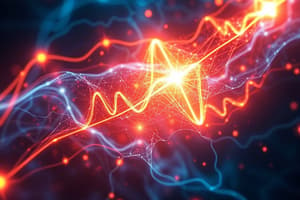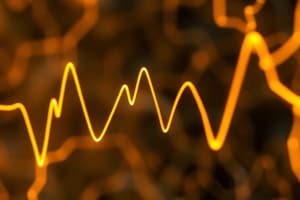Podcast
Questions and Answers
What are the two types of signals produced by changes in membrane potential?
What are the two types of signals produced by changes in membrane potential?
Graded potentials and Action potentials
Which of the following is another name for an action potential?
Which of the following is another name for an action potential?
- Spike
- Nerve impulse
- Discharge
- All of the above (correct)
Action potentials occur only in muscle cells.
Action potentials occur only in muscle cells.
False (B)
What is the resting membrane potential of a resting neuron?
What is the resting membrane potential of a resting neuron?
What triggers the generation of an action potential?
What triggers the generation of an action potential?
Match the following phases of an action potential with their descriptions:
Match the following phases of an action potential with their descriptions:
What happens during the relative refractory period?
What happens during the relative refractory period?
What is the key voltage number associated with the threshold for action potential generation?
What is the key voltage number associated with the threshold for action potential generation?
What are the two main factors that affect action potential conduction velocity?
What are the two main factors that affect action potential conduction velocity?
Saltatory conduction occurs only in non-myelinated axons.
Saltatory conduction occurs only in non-myelinated axons.
What is an example of a disease that affects myelin sheaths?
What is an example of a disease that affects myelin sheaths?
Flashcards are hidden until you start studying
Study Notes
Action Potential Overview
- Action potentials are long-distance signals crucial for communication in neurons and muscle cells.
- Changes in membrane potential result from ion concentration gradients and membrane permeability alterations.
Membrane Potential Changes
- Resting Membrane Potential: Approximately -70 mV, with variations between -40 mV to -90 mV due to ionic composition.
- Depolarization: Decrease toward zero, increases impulse probability by making the inside less negative.
- Hyperpolarization: Increase away from zero, decreases impulse probability by making the inside more negative.
Phases of Action Potentials
- Four distinct phases:
- Resting Phase: All gated sodium (Na+) and potassium (K+) channels are closed.
- Depolarization Phase: Na+ channels open, leading to Na+ influx and drastic membrane potential increase (~+30 mV).
- Repolarization Phase: Na+ channels inactivate, K+ channels open, causing K+ to exit and membrane returns to resting state.
- Hyperpolarization Phase: Some K+ channels remain open, leading to a more negative inside potential than resting state.
Generation of Action Potentials
- Initiated by depolarization that exceeds the threshold (-55 to -50 mV).
- All-or-None Principle: Action potentials occur fully once the threshold is crossed; they do not partially fire.
- Propagation: Local depolarization due to Na+ influx triggers further depolarization in adjacent segments.
Refractory Periods
- Absolute Refractory Period: Following AP initiation, a neuron cannot fire until Na+ channels reset, ensuring one-way transmission.
- Relative Refractory Period: Occurs after the absolute period when some Na+ channels are reset, requiring a stronger stimulus to trigger another AP.
Conduction Velocity
- Influenced by two primary factors:
- Axon Diameter: Larger diameters result in faster conduction due to reduced resistance.
- Degree of Myelination: Myelinated axons use saltatory conduction, significantly increasing AP speed compared to continuous conduction in unmyelinated axons.
Pathological Considerations
- Multiple Sclerosis (MS): An autoimmune disorder where myelin sheaths in the CNS are destroyed, slowing or halting impulse conduction.
Key Voltage Points
- Important thresholds include resting potential at -70 mV, action potential peak around +30 mV, and various ion channel behaviors tied to specific membrane potentials.
Summary of Voltage-Gated Channels
- Sodium Channels:
- Open with little delay and remain open for about 1 ms.
- Have dual activation and inactivation gates crucial for preventing excessive firing.
- Potassium Channels:
- Open at +30 mV and help reset the membrane potential during repolarization.
Clinical Connections
- Dysfunction in voltage-gated channels can lead to channelopathies, exemplified by certain genetic conditions causing neurological issues.
Studying That Suits You
Use AI to generate personalized quizzes and flashcards to suit your learning preferences.




